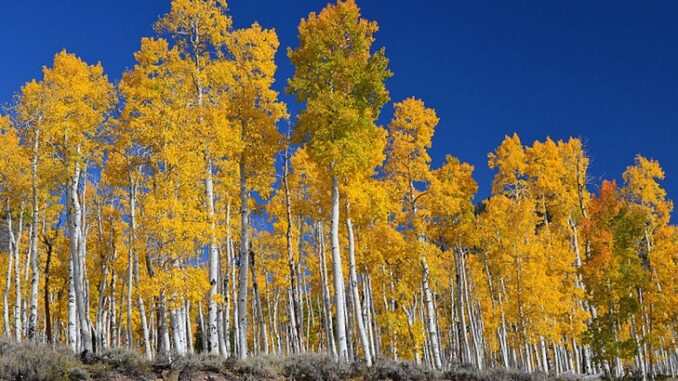
Aspens are a favorite with many people for their autumn color and the way their leaves rattle and quake on the wind. One grove of aspen in the Fishlake National Forest, Wasatch Mountains, south central Utah, has become somewhat well known if not famous. Pando is Latin for “I spread” – an appropriate name for a self-cloning tree that has grown to cover more than 106 acres. There are many groves of Populus tremuloides in North America but to the best of anyone’s knowledge, Pando is the oldest and largest (by estimated mass) individual organism in the world. The distinction of being a single tree with forty-seven thousand genetically identical tree trunks (known as stems) that grow from a massive root system, was determined by DNA testing. Aspen trees typically grow to be anywhere from 20–25 meters (65–80 feet) tall, and live 100-120 years on average. The tree-clones age and die but the root system they grew from lives on, continuously sprouting new stems.
Pando was first identified as a single organism in 1976. Subsequent studies verified that Pando is indeed a single living thing that reproduces by spreading its root system underground and sprouting clones of itself that look like separate trees to the casual observer. Pando is also quite old, but no one one knows with certainty just how old. At the very least, this aspen grove is likely at least 10,000 years of age. The last glacier affecting this area of Utah receded about 16,000 years ago, suggesting Pando must be younger than the last ice sheet. However, on the wilder side, there are estimates from 80,000 to one million years old.
Aspen groves all across the western United States are under stress from several vectors. For starters, deer, elk, and free range cattle graze on the young aspen stems, preventing the ancient roots from growing new trees which the organism needs to survive. Before man slashed the numbers of wolves and mountain lions, these predators kept ungulates in check and constantly on the move, limiting grazing. Drought and warming temperatures are additional stressors. Paradoxically, strict forest fire prevention measures also contribute to the aspen’s woes, as the species needs fire to thrive. Lastly, conk fungal disease, leaf spot, and sooty bark canker are taking their toll as well.
Populus tremuloides is an important tree in the forest ecosystem. Scientists and forestry experts are working to find relief for Pando and other stressed aspen groves.
Scientific Classification
Kingdom: Plantae
Clade: Tracheophytes
Clade: Angiosperms
Clade: Eudicots
Clade: Rosids
Order: Malpighiales
Family: Salicaceae
Genus: Populus
Species: P. tremuloides
Binomial name: Populus tremuloides (Michx.)
“Aspen Pando” Utah State University Extension (1:26)
“Earth’s most massive living thing is struggling to survive” (5:42)
“Fishlake National Forest Pando Clone” US Forest Service (7:34)
